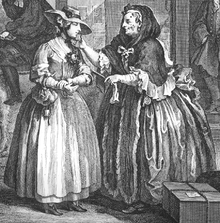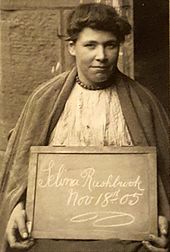Prostitution in the United Kingdom
In Great Britain (England, Wales and Scotland), the act of engaging in prostitution or exchanging various sexual services for money is legal,[2] but a number of related activities, including soliciting in a public place, kerb crawling, owning or managing a brothel, and pimping, are illegal.
[3] Though laws regulating sex work exist, they are not always strictly enforced, with some reports in March 2016 of police forces turning a blind eye to brothels.
[11] In 2015, the HMRC set up a dedicated "adult entertainment task force" to collect unpaid income tax from, among others, online escort agencies.
In 2003, undercover police visited the lap dancing club Spearmint Rhino on Tottenham Court Road in London and claimed that it was a front for prostitution.
The authors stress the difficulty of finding reliable data given the lack of prior research, differences in sample sizes, and possible underestimates due to the privacy concerns of survey respondents.
[26] A study published by Swansea University in March 2015 found that nearly 5% of UK students had been involved in sex work in some capacity, including prostitution.
[31] The committee recommended that, given the current absence of robust data on the subject, the Home Office should commission a research study to inform future legislation.
[29] One of the earliest pieces of evidence for prostitution in the country was given by the discovery on the banks of the River Thames of a Roman spintria, a small bronze token, depicting a man and a woman engaged in a sexual act.
The regulation of prostitution in England lasted until 1546, when a fear that brothels were contributing to the spread of syphilis resulted in Henry VIII issuing a royal proclamation.
[41] Bullough argues that prostitution in 18th-century Britain was a convenience to men of all social statuses, and an economic necessity for many poor women, and was tolerated by society.
The rise of middle-class domestic morality and the separation of men's and women's activity into separate spheres made it increasingly hard for women to obtain work, causing an increase in such areas as the needle-trade, shop girls, agricultural gangs, factory work, and domestic servants,[46] all occupations with long hours and low pay.
Low earnings, it is argued,[47] meant that women had to resort to prostitution to be able to provide for themselves and their families, particularly in households where the main breadwinner was no longer around.
A series of small books, The Swell's Night Guides, listed the advantages and drawbacks of various theatres for men seeking pleasure, and gave advice on how to approach actresses.
As Donald Thomas put it in Villains' Paradise: The Street Offences Act of 1959 sought to prevent the public nuisance of having prostitutes on the pavements and thereby turned most of them into 'call-girls'.
[66] A second Home Office review, Tackling the demand for prostitution (2008), proposed the development of a new offence to criminalise those who pay for sex with a person who is being controlled against their wishes for someone else's gain.
In 2015, the UK Government "legislated through the Serious Crime Act 2015 to remove all references to 'child prostitution' from the law, in order to reflect the true nature of this activity as sexual exploitation".
[64] Adverts for prostitutes have also been placed in public telephone boxes (where they are known as tart cards) despite the Criminal Justice and Police Act 2001 making such advertising an offence.
The News Media Association's guidelines suggest that their members (the majority of local newspapers) refuse to carry advertisements for sexual services.
"[105] The results were as follows:[106] In 2006, the Labour government raised the possibility of revising the prostitution laws, to allow small brothels in England and Wales.
[citation needed] On the subject of local regulation, a spokeswoman for the English Collective of Prostitutes commented in 2016: "A managed zone is no substitute for decriminalisation.
[108][109] The Association of Chief Police Officers suggested that designated red-light zones and decriminalised brothels might help to improve prostitutes' safety.
[4] In March 2016, Labour Party leader Jeremy Corbyn, speaking to students at Goldsmiths, University of London, said that he was "in favour of decriminalising the sex industry".
In March 2014 an all-party parliamentary group in the House of Commons issued a report called Shifting the Burden[121] which claimed that the current legislation is complicated and confusing.
The report proposed the introduction of the Nordic model of prostitution to England and Wales,[122] consolidating current legislation into a single act with a general offence for the purchase of sexual services.
[124] In response, Shadow Home Secretary Yvette Cooper put forward an alternative amendment which called for a period of review and research.
[126] In January 2016 the Home Affairs Select Committee began an inquiry into prostitution legislation, including trying to assess "whether the balance in the burden of criminality should shift to those who pay for sex rather than those who sell it".
[31] University of Leeds research in 2015 found that 47% of prostitutes had been victims of crime, including rape and robbery, while 36% had received threatening texts, telephone calls or emails.
[138] A 2007 UN report identified the major sources of trafficked persons include Thailand, China, Nigeria, Albania, Bulgaria, Belarus, Moldova and Ukraine.
[141] A study carried out in 2011 by London Metropolitan University and funded by the Government's Economic and Social Research Council found that 6% of prostitutes "felt" they were "deceived and forced" into the work.
"[142] However, the ESRC survey remains controversial as its data are derived from post-facto interviews with sex workers whose susceptibility to Stockholm syndrome and other psychological traumas is well-documented.



